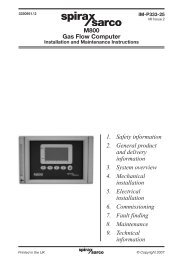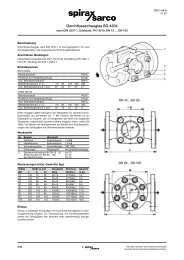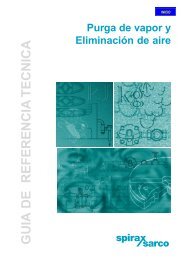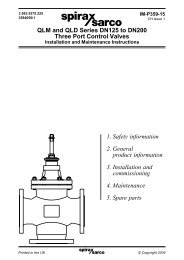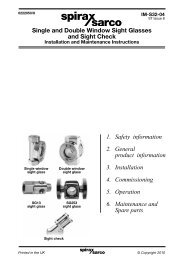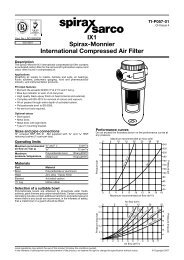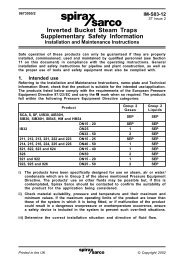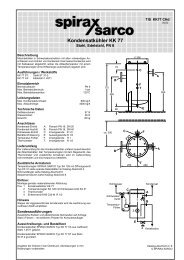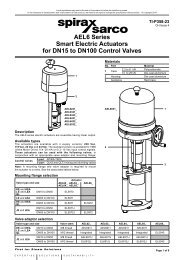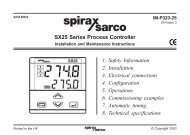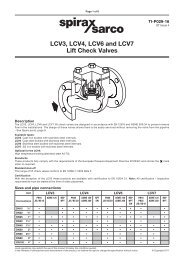2000 Hook-up Book - Spirax Sarco
2000 Hook-up Book - Spirax Sarco
2000 Hook-up Book - Spirax Sarco
You also want an ePaper? Increase the reach of your titles
YUMPU automatically turns print PDFs into web optimized ePapers that Google loves.
Closed Circuit Cooling<br />
Especially with large compressors,<br />
economies are obtained<br />
when the cooling water is recycled<br />
in a closed circuit. This also<br />
minimizes any scaling in the jackets<br />
and coolers. The heat may be<br />
dissipated at a cooling tower or a<br />
mechanical cooler, or sometimes<br />
used for space heating in adjacent<br />
areas.<br />
Usually with closed circuit cooling,<br />
it is preferable to use<br />
three-way temperature controls.<br />
Where cooling towers are used,<br />
freeze protection of the tower<br />
sump may be needed in winter<br />
conditions. Often a steam heating<br />
coil is installed in the sump with a<br />
temperature control set to open<br />
when the water temperature falls<br />
to say 35°F. A three-way temperature<br />
control diverts water direct<br />
to the sump instead of to the top<br />
of the tower in low temperature<br />
conditions. Heat loss from the<br />
sump itself then provides sufficient<br />
cooling.<br />
Air is a vital utility for all process plants, primarily to power<br />
control valves, measurement devices and to drive tools,<br />
pumps, machinery, etc. Outdoor facilities (i.e. refineries<br />
and chemical plants) are faced with continual problems<br />
related to water accumulation in the air system.<br />
Free and compressed air carries varying volumes of<br />
water at different pressures and temperatures. This affects<br />
the amount of entrained water that must be drained in different<br />
parts of the system for effective operation.<br />
Desiccant dryers critical for removing water from compressed<br />
air distributed to instruments and controls<br />
become water-logged due to excess moisture entrained in<br />
the free-air s<strong>up</strong>plied. When this occurs, the dryers shut<br />
down, curtailing air for distribution.<br />
The heat transfer across the wall of distribution piping<br />
creates additional condensing. Moisture, entrained in the air<br />
flow, exceeds the capacity of the coalescent filters installed<br />
at the point of use. The air-using equipment is then flooded<br />
with water, affecting proper operation. This can ruin gauges<br />
and instruments and affect control accuracy.<br />
Lubricant Coolers<br />
On large reciprocating compressors,<br />
and especially on rotary<br />
vane compressors, the lubricating<br />
oil is usually cooled by passing it<br />
through a heat exchanger. Here it<br />
gives <strong>up</strong> heat to cooling water<br />
and again the coolant flow should<br />
be temperature controlled. See<br />
Fig. 65.<br />
Compressed Air Systems<br />
Bypass if<br />
necessary<br />
Compressor Equipment Guide<br />
Approx. CFM Air =<br />
Compressor HP X 5<br />
GPM Cooling Water =<br />
42.5 X HP/Cylinder<br />
8.33 X Temp. Rise<br />
of Cooling Water<br />
Figure 65<br />
Temperature Control of Water to Oil Cooler<br />
Case in Action: Air System Moisture Separation/Drainage<br />
Strainer<br />
Sensor<br />
Reverse Acting<br />
Temperature<br />
Control<br />
Solution<br />
Over 30 separators with drain traps were installed in problem<br />
areas providing proper drainage of equipment.<br />
Benefits<br />
• Continuous operation of desiccant dryers, assuring<br />
uninterr<strong>up</strong>ted air s<strong>up</strong>ply.<br />
• Working with dry air, instrument accuracy is more consistent.<br />
• Damage to gauges and other instruments, caused by<br />
entrained water, is prevented, reducing maintenance<br />
cost.<br />
• Air hose stations deliver dry air immediately eliminating<br />
delay/inconvenience of having to manually drain water<br />
from the hoses before use.<br />
65<br />
SYSTEM DESIGN



